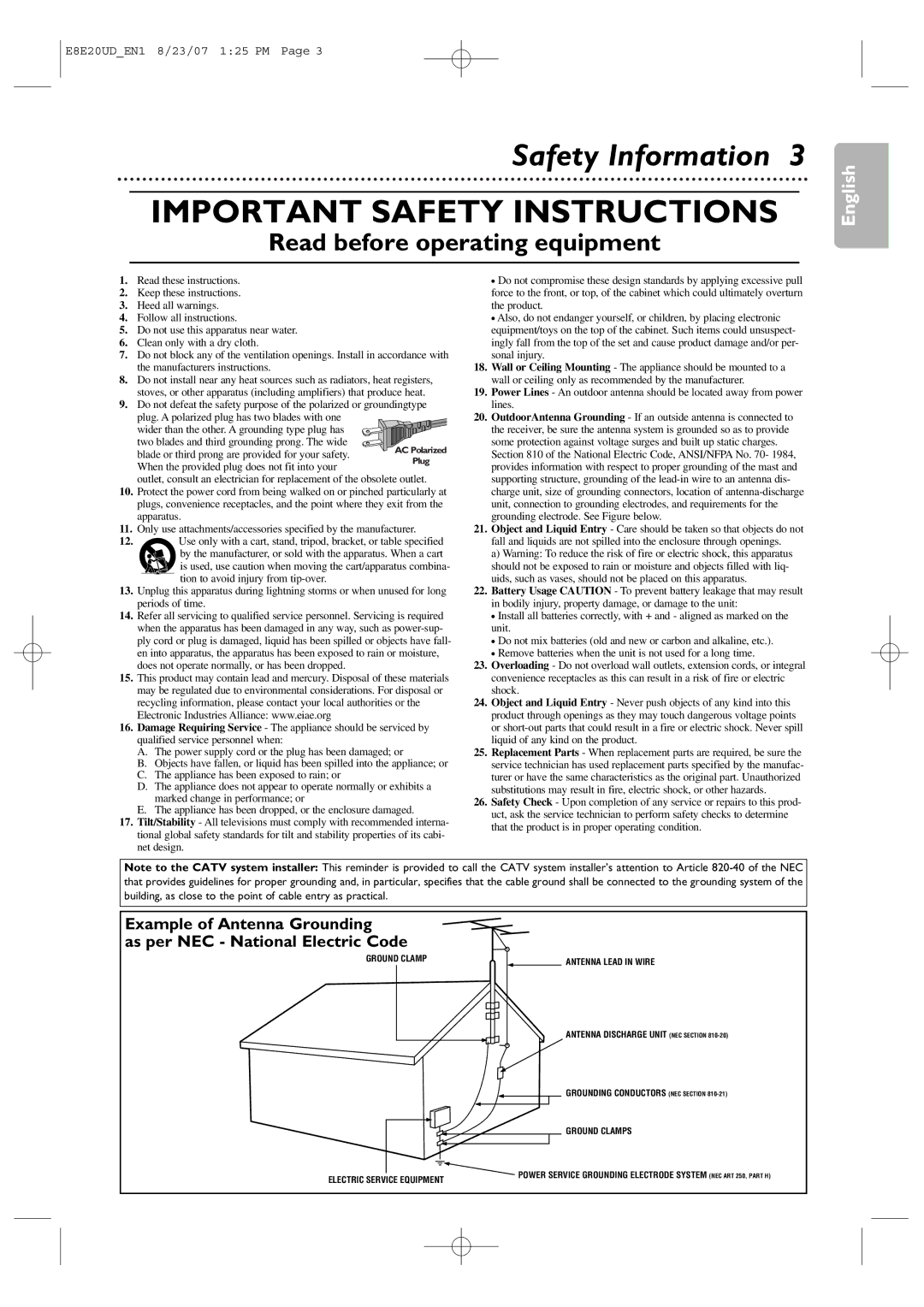
E8E20UD_EN1 8/23/07 1:25 PM Page 3
Safety Information 3
IMPORTANT SAFETY INSTRUCTIONS
Read before operating equipment
English
1.Read these instructions.
2.Keep these instructions.
3.Heed all warnings.
4.Follow all instructions.
5.Do not use this apparatus near water.
6.Clean only with a dry cloth.
7.Do not block any of the ventilation openings. Install in accordance with the manufacturers instructions.
8.Do not install near any heat sources such as radiators, heat registers, stoves, or other apparatus (including amplifiers) that produce heat.
9.Do not defeat the safety purpose of the polarized or groundingtype
plug. A polarized plug has two blades with one
wider than the other. A grounding type plug has two blades and third grounding prong. The wide
blade or third prong are provided for your safety. When the provided plug does not fit into your
outlet, consult an electrician for replacement of the obsolete outlet.
10.Protect the power cord from being walked on or pinched particularly at plugs, convenience receptacles, and the point where they exit from the apparatus.
11.Only use attachments/accessories specified by the manufacturer.
12.Use only with a cart, stand, tripod, bracket, or table specified
by the manufacturer, or sold with the apparatus. When a cart is used, use caution when moving the cart/apparatus combina- tion to avoid injury from
13.Unplug this apparatus during lightning storms or when unused for long periods of time.
14.Refer all servicing to qualified service personnel. Servicing is required when the apparatus has been damaged in any way, such as
15.This product may contain lead and mercury. Disposal of these materials may be regulated due to environmental considerations. For disposal or recycling information, please contact your local authorities or the Electronic Industries Alliance: www.eiae.org
16.Damage Requiring Service - The appliance should be serviced by qualified service personnel when:
A.The power supply cord or the plug has been damaged; or
B.Objects have fallen, or liquid has been spilled into the appliance; or
C.The appliance has been exposed to rain; or
D.The appliance does not appear to operate normally or exhibits a marked change in performance; or
E.The appliance has been dropped, or the enclosure damaged.
17.Tilt/Stability - All televisions must comply with recommended interna- tional global safety standards for tilt and stability properties of its cabi- net design.
●Do not compromise these design standards by applying excessive pull force to the front, or top, of the cabinet which could ultimately overturn the product.
●Also, do not endanger yourself, or children, by placing electronic equipment/toys on the top of the cabinet. Such items could unsuspect- ingly fall from the top of the set and cause product damage and/or per- sonal injury.
18.Wall or Ceiling Mounting - The appliance should be mounted to a wall or ceiling only as recommended by the manufacturer.
19.Power Lines - An outdoor antenna should be located away from power lines.
20.OutdoorAntenna Grounding - If an outside antenna is connected to the receiver, be sure the antenna system is grounded so as to provide some protection against voltage surges and built up static charges.
Section 810 of the National Electric Code, ANSI/NFPA No. 70- 1984, provides information with respect to proper grounding of the mast and supporting structure, grounding of the
21.Object and Liquid Entry - Care should be taken so that objects do not fall and liquids are not spilled into the enclosure through openings.
a) Warning: To reduce the risk of fire or electric shock, this apparatus should not be exposed to rain or moisture and objects filled with liq- uids, such as vases, should not be placed on this apparatus.
22.Battery Usage CAUTION - To prevent battery leakage that may result in bodily injury, property damage, or damage to the unit:
●Install all batteries correctly, with + and - aligned as marked on the unit.
●Do not mix batteries (old and new or carbon and alkaline, etc.).
●Remove batteries when the unit is not used for a long time.
23.Overloading - Do not overload wall outlets, extension cords, or integral convenience receptacles as this can result in a risk of fire or electric shock.
24.Object and Liquid Entry - Never push objects of any kind into this product through openings as they may touch dangerous voltage points or
25.Replacement Parts - When replacement parts are required, be sure the service technician has used replacement parts specified by the manufac- turer or have the same characteristics as the original part. Unauthorized substitutions may result in fire, electric shock, or other hazards.
26.Safety Check - Upon completion of any service or repairs to this prod- uct, ask the service technician to perform safety checks to determine that the product is in proper operating condition.
Note to the CATV system installer: This reminder is provided to call the CATV system installer’s attention to Article
Example of Antenna Grounding
as per NEC - National Electric Code
GROUND CLAMP | ANTENNA LEAD IN WIRE |
|
| ANTENNA DISCHARGE UNIT (NEC SECTION |
| GROUNDING CONDUCTORS (NEC SECTION |
| GROUND CLAMPS |
ELECTRIC SERVICE EQUIPMENT | POWER SERVICE GROUNDING ELECTRODE SYSTEM (NEC ART 250, PART H) |
|
